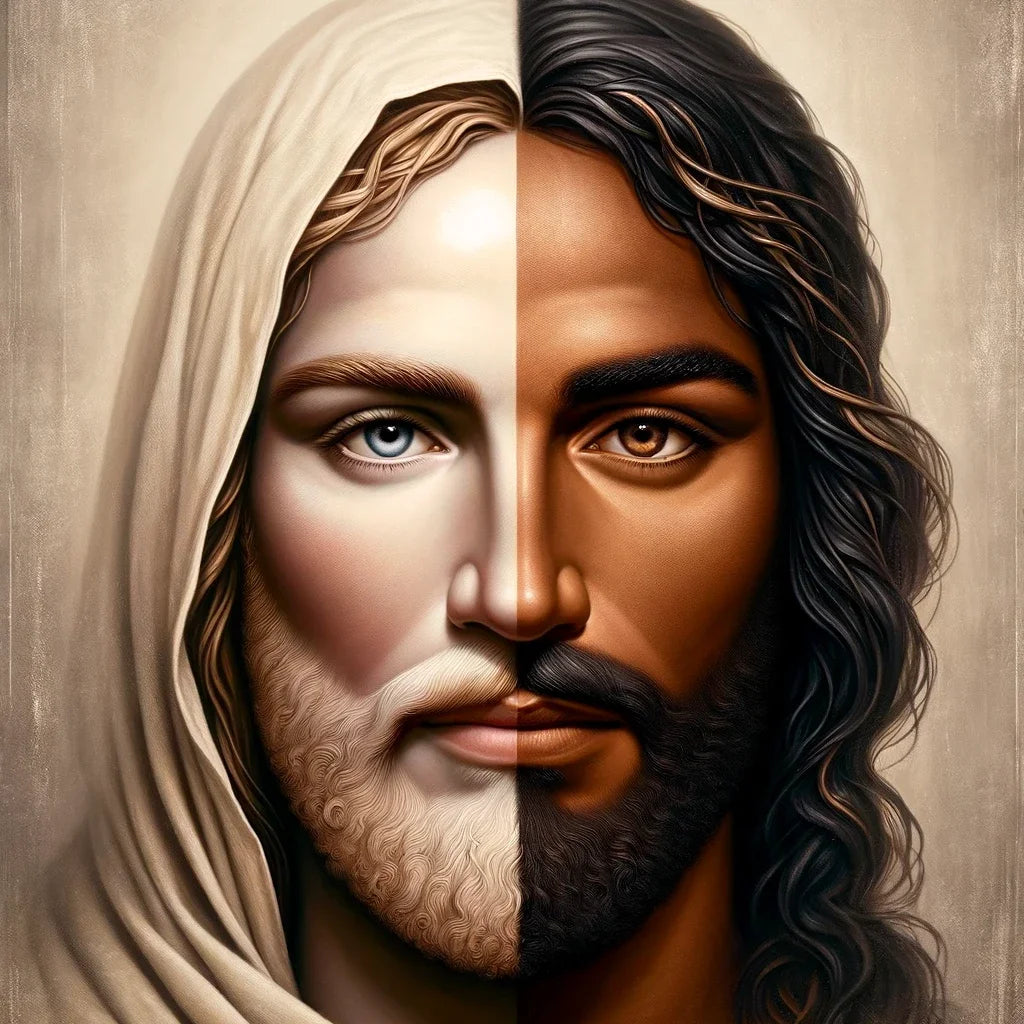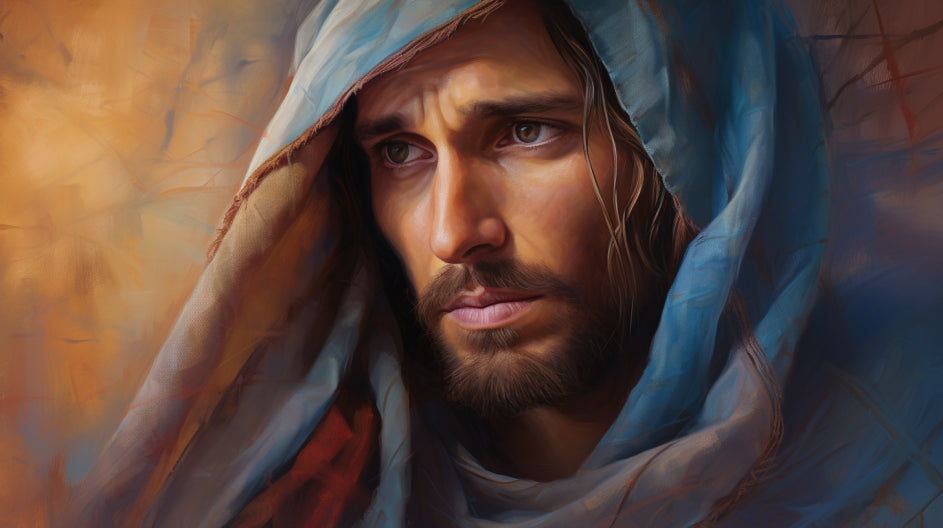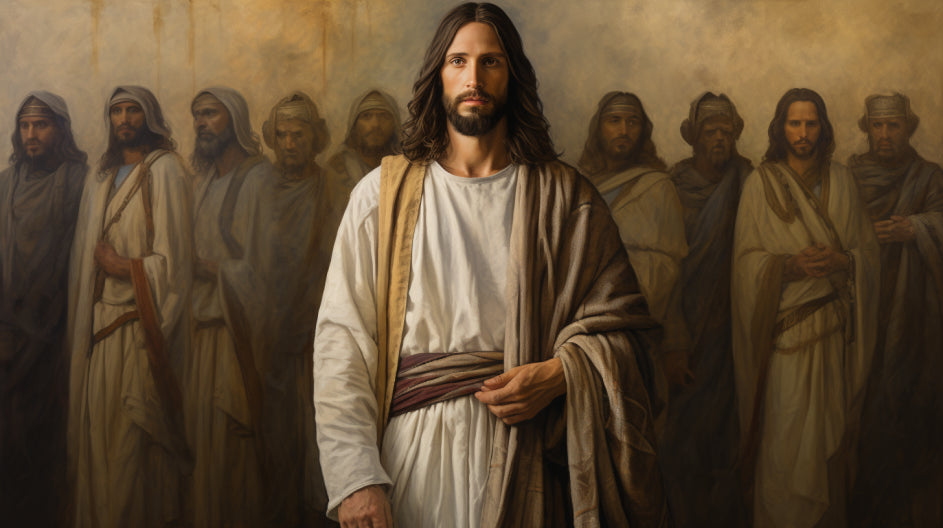
Why Is Jesus Portrayed as White
Share
Every corner of the globe has been touched by the image of a white Jesus. We're diving headfirst into the captivating question: why is Jesus so often depicted as a Caucasian man? With origins rooted in the Middle East, the whitewashing of this pivotal figure raises thought-provoking questions about cultural influence and representation. We'll sift through historical records, analyze the impact of European global influence, and challenge societal norms. Our goal is to reframe perspectives, stimulate fresh dialogues, and encourage a shift towards a more inclusive portrayal. It's time to unravel this complex topic and shed light on the true colors of history.
topic and shed light on the true colors of history.
Colossians 3:11: 'Here there is no Gentile or Jew, circumcised or uncircumcised, barbarian, Scythian, slave or free, but Christ is all, and is in all.' This verse emphasizes the universality of Christ beyond ethnic or social distinctions, suggesting that His presence and significance transcend any one cultural or racial identity. Acts 17:26: 'From one man he made all the nations, that they should inhabit the whole earth; and he marked out their appointed times in history and the boundaries of their lands.' This scripture from Acts speaks to the creation of all peoples from one source, highlighting the shared humanity and diversity within God's creation, which is a critical perspective when considering the varied representations of Jesus Christ across cultures. Revelation 1:14-15: 'The hair on his head was white like wool, as white as snow, and his eyes were like blazing fire. His feet were like bronze glowing in a furnace...' Although this apocalyptic vision uses symbolic language to describe Jesus in a glorified state, it has sometimes been cited in artistic interpretations. It’s important to note that these descriptions are metaphorical, reflecting attributes of purity, judgment, and divinity rather than physical characteristics. Galatians 2:20: 'I have been crucified with Christ and I no longer live, but Christ lives in me. The life I now live in the body, I live by faith in the Son of God, who loved me and gave himself for me.' This verse reflects the deep, personal relationship between believers and Christ, emphasizing a spiritual connection that surpasses physical appearance. 1 Samuel 16:7: 'But the Lord said to Samuel, "Do not consider his appearance or his height, for I have rejected him. The Lord does not look at the things people look at. People look at the outward appearance, but the Lord looks at the heart."' While this Old Testament scripture is not directly about Jesus, it offers a pertinent reminder of the priority of spiritual and moral qualities over physical characteristics, a principle that can be applied to discussions about the representation of Jesus. 3 Nephi 28:3 (Book of Mormon): 'And he said unto them: Blessed are ye because ye desired this thing of me; therefore, after that ye are seventy and two years old ye shall come unto me in my kingdom; and with me ye shall find rest.' While this verse specifically addresses the desire of the disciples to join Jesus in His kingdom, it metaphorically underscores the idea that followers of Christ seek a spiritual kingdom, not one defined by earthly or physical distinctions. In discussing "Why is Jesus Portrayed as White?" it's essential to engage with the complex interplay of history, culture, and spirituality that has influenced the depiction of Jesus Christ throughout the ages. These scriptural references provide a spiritual context that encourages a move beyond the physical portrayal to the universal and inclusive message of Christ's teachings and ministry. These scriptures, along with the provided contexts, can serve as a thoughtful basis for exploring the reasons behind and implications of portraying Jesus as white, inviting a broader conversation about representation, identity, and the diverse ways in which the figure of Jesus Christ is understood and visualized across cultures. As we proceed to discuss 'Why is Jesus Portrayed as White', we'll dissect the historical, cultural, and artistic reasons behind this representation. We'll examine the controversial topic of Jesus' depiction as white in art and offer a brief overview of the historical context. This exploration aims to provide a comprehensive understanding of the factors that influenced such portrayals, thus shedding light on a critical aspect of religious iconography.







 This white Jesus narrative, deeply rooted in Eurocentric power structures, perpetuates racial biases. It's a reflection of societal structures where the dominant group controls the representation, subtly reinforcing its superiority. This can have an influence on our cultural understanding of divinity and racial identity.
This white Jesus narrative, deeply rooted in Eurocentric power structures, perpetuates racial biases. It's a reflection of societal structures where the dominant group controls the representation, subtly reinforcing its superiority. This can have an influence on our cultural understanding of divinity and racial identity.











 topic and shed light on the true colors of history.
topic and shed light on the true colors of history.
Key Takeaways
- Jesus's appearance is not described in the Gospels, but he was known as Jesus of Nazareth from Galilee.
- The traditional European depictions of Jesus may not accurately represent his probable appearance.
-
Images of Jesus should be inculturated into every culture and celebrate diversity.

Why is Jesus Portrayed as White
This controversial question delves into the historical, cultural, and sociological reasons behind the common Western depiction of Jesus Christ as a white figure. This portrayal has been shaped by various influences over the centuries, including artistic convention, cultural context, and theological interpretation. While the Bible does not provide a detailed description of Jesus's physical appearance, the diverse representations of Jesus reflect the changing attitudes and identities of the communities that honor Him. Below, we will explore scriptural references that underscore the transcendent and inclusive nature of Jesus's identity, offering a foundation for discussing the broader implications of His depiction in art.Colossians 3:11: 'Here there is no Gentile or Jew, circumcised or uncircumcised, barbarian, Scythian, slave or free, but Christ is all, and is in all.' This verse emphasizes the universality of Christ beyond ethnic or social distinctions, suggesting that His presence and significance transcend any one cultural or racial identity. Acts 17:26: 'From one man he made all the nations, that they should inhabit the whole earth; and he marked out their appointed times in history and the boundaries of their lands.' This scripture from Acts speaks to the creation of all peoples from one source, highlighting the shared humanity and diversity within God's creation, which is a critical perspective when considering the varied representations of Jesus Christ across cultures. Revelation 1:14-15: 'The hair on his head was white like wool, as white as snow, and his eyes were like blazing fire. His feet were like bronze glowing in a furnace...' Although this apocalyptic vision uses symbolic language to describe Jesus in a glorified state, it has sometimes been cited in artistic interpretations. It’s important to note that these descriptions are metaphorical, reflecting attributes of purity, judgment, and divinity rather than physical characteristics. Galatians 2:20: 'I have been crucified with Christ and I no longer live, but Christ lives in me. The life I now live in the body, I live by faith in the Son of God, who loved me and gave himself for me.' This verse reflects the deep, personal relationship between believers and Christ, emphasizing a spiritual connection that surpasses physical appearance. 1 Samuel 16:7: 'But the Lord said to Samuel, "Do not consider his appearance or his height, for I have rejected him. The Lord does not look at the things people look at. People look at the outward appearance, but the Lord looks at the heart."' While this Old Testament scripture is not directly about Jesus, it offers a pertinent reminder of the priority of spiritual and moral qualities over physical characteristics, a principle that can be applied to discussions about the representation of Jesus. 3 Nephi 28:3 (Book of Mormon): 'And he said unto them: Blessed are ye because ye desired this thing of me; therefore, after that ye are seventy and two years old ye shall come unto me in my kingdom; and with me ye shall find rest.' While this verse specifically addresses the desire of the disciples to join Jesus in His kingdom, it metaphorically underscores the idea that followers of Christ seek a spiritual kingdom, not one defined by earthly or physical distinctions. In discussing "Why is Jesus Portrayed as White?" it's essential to engage with the complex interplay of history, culture, and spirituality that has influenced the depiction of Jesus Christ throughout the ages. These scriptural references provide a spiritual context that encourages a move beyond the physical portrayal to the universal and inclusive message of Christ's teachings and ministry. These scriptures, along with the provided contexts, can serve as a thoughtful basis for exploring the reasons behind and implications of portraying Jesus as white, inviting a broader conversation about representation, identity, and the diverse ways in which the figure of Jesus Christ is understood and visualized across cultures. As we proceed to discuss 'Why is Jesus Portrayed as White', we'll dissect the historical, cultural, and artistic reasons behind this representation. We'll examine the controversial topic of Jesus' depiction as white in art and offer a brief overview of the historical context. This exploration aims to provide a comprehensive understanding of the factors that influenced such portrayals, thus shedding light on a critical aspect of religious iconography.
The controversial topic of Jesus' portrayal as white in art
In our exploration of art, we've often asked, 'Why is Jesus portrayed as white?' This controversial topic of Jesus' portrayal as white in art is multifaceted.- Historical Context
- European Renaissance artists often depicted Christ in their own image, leading to a Eurocentric representation.
- Current Debates
- Activists argue these depictions contribute to systemic racism, urging for reconsideration of Jesus' portrayal.
- Scholars advocate for more historically accurate, Middle Eastern representations.

Historical context of Jesus' depiction
The white European portrayal stems from the middle ages when European artists began painting biblical figures, including Jesus, in their own image. This portrayal of Jesus as white was then propagated globally through colonialism, missionary work, and mass media. Despite the historical context and geographical setting of Jesus' life pointing towards a Middle Eastern appearance, the image of a white Jesus persists due to these historical influences. This depiction not only misrepresents Jesus' probable appearance but also, inadvertently, promotes a Eurocentric worldview. The white Jesus has been a powerful symbol in Western art, however, it may not fully align with historical accuracy.- Jesus was a Galilean Jew, likely having Middle Eastern characteristics.
- The white portrayal aligns more with European features, indicating an ethnocentric projection.
- Art often mirrors the society in which it's produced, thus European artists portrayed Jesus as white.



Symbols and allegorical representations
Drawing from early Christian art, we can see that symbols and allegorical representations played a major role in depicting Jesus, rather than a focus on his physical appearance. These representations often transcended racial boundaries, focusing on spiritual symbolism.

Renaissance era and the development of European iconography
In the Renaissance era, a pivotal shift occurred that influenced the portrayal of Jesus in art and iconography. This period saw a convergence of religious ideals and artistic expression, which led to Jesus being depicted in a manner reflective of European identity. We must explore this development and its implications to understand the historical perspective of Jesus' portrayal.

Impact on global spread of Christianity
European dominance led to the widespread dissemination of a 'White Jesus.' This Eurocentric depiction of Jesus undeniably influenced the global spread of Christianity. It created a skewed perception of Christianity as a 'white' religion, which in turn affected how people around the world perceived and practiced the faith. Additionally, missionaries played a crucial role in disseminating European art, including images of a white Jesus. These missionaries, often sent by European colonial powers, brought with them their own cultural and religious beliefs. As they spread Christianity, they also spread European art and imagery, including depictions of Jesus that aligned with their own understanding of what he looked like. By promoting and popularizing these images, missionaries reinforced the idea of Jesus as a white figure and contributed to the global perception of Christianity as a 'white' religion. This had long-lasting effects on how Christianity was understood and practiced in different parts of the world.Eurocentrism and racial biases
The prevailing European standards of beauty have undeniably influenced the image of a white Jesus, reinforcing a Eurocentric worldview. Additionally, examining the correlation between power dynamics and the portrayal of Jesus allows us to further understand the pervasiveness of racial biases in religious iconography. This white Jesus narrative, deeply rooted in Eurocentric power structures, perpetuates racial biases. It's a reflection of societal structures where the dominant group controls the representation, subtly reinforcing its superiority. This can have an influence on our cultural understanding of divinity and racial identity.
This white Jesus narrative, deeply rooted in Eurocentric power structures, perpetuates racial biases. It's a reflection of societal structures where the dominant group controls the representation, subtly reinforcing its superiority. This can have an influence on our cultural understanding of divinity and racial identity.
Role of patronage and the elites in commissioning art
While we're discussing the portrayal of Jesus in art, it's important to understand that much of the artwork was commissioned by wealthy patrons and elites, shaping the depictions based on their own cultural understandings and societal norms.
Theological Interpretations and Symbolism in Art
In interpreting Jesus' portrayal, it might help to consider theological interpretations and the symbolism employed in art. These elements often connect to Jesus' spiritual nature and have been expressed differently across cultures. While the perceived dominant white portrayal of Jesus reflects a particular cultural interpretation, it's worth investigating how other cultures have artistically interpreted his characteristics.
Connection between Jesus' spiritual nature and artistic representation
Artistic representations of Jesus have long grappled with the challenge of embodying His divine nature in physical form. These depictions often employ metaphorical and symbolic elements to convey spiritual truths. Artists have long-faced the challenge of capturing the divine nature of Jesus in physical form through art. The prevalent white depiction of Jesus has been criticized for its lack of historical and cultural accuracy.- Theological Interpretations:The divine nature of Jesus transcends racial boundaries
- Symbolism in Art: White Jesus depictions often symbolize purity
- A more diverse representation could symbolize universal divinity


Examination of cultural interpretations and artistic flexibility
Examining cultural interpretations and artistic flexibility, we find a wide range of depictions of Jesus' characteristics influenced by various theological interpretations and symbolism in different cultures.- Western culture often depicts Jesus as a white man, reflecting its theological perspectives.
- Asian cultures, however, portray Jesus with Asian features, symbolizing His universality.
- African cultures often portray an African deity.

Public Perception and Influence
The wide circulation of predominantly white Jesus portraits has had a profound impact on public perception, shaping societal norms and beliefs. This imagery's implications extend to issues of racial identity, influencing how individuals perceive themselves and others. We are invited to examine these representations and their influence, understanding their role in a broader socio-cultural context.
Popular images that have become iconic
Let's explore some of the most iconic images of Jesus that have had a profound influence on public perception.- Warner Sallman's 'Head of Christ'
- Widely circulated White Jesus depiction
- European Renaissance Art
- Jesus typically depicted white


The potential for promoting inclusivity through diverse depictions
In recent years, we've witnessed a surge of contemporary artists who create new interpretations that seek to diversify his image.
Promoting a worshipful expression of art
We must emphasize that the spiritual essence of Jesus transcends physical appearance in worship. Also, it is helpful to remember that Jesus came to point man to God and often we can find ourselves stumble over our set concepts and even laser-focus on the person of Jesus rather than the God he came to promote.
Emphasize the spiritual essence above physical appearance in worship
Let's shift our focus to the importance of emphasizing the spiritual essence over physical appearance in our worship, challenging the traditional portrayal and promoting a more worshipful expression of art.





